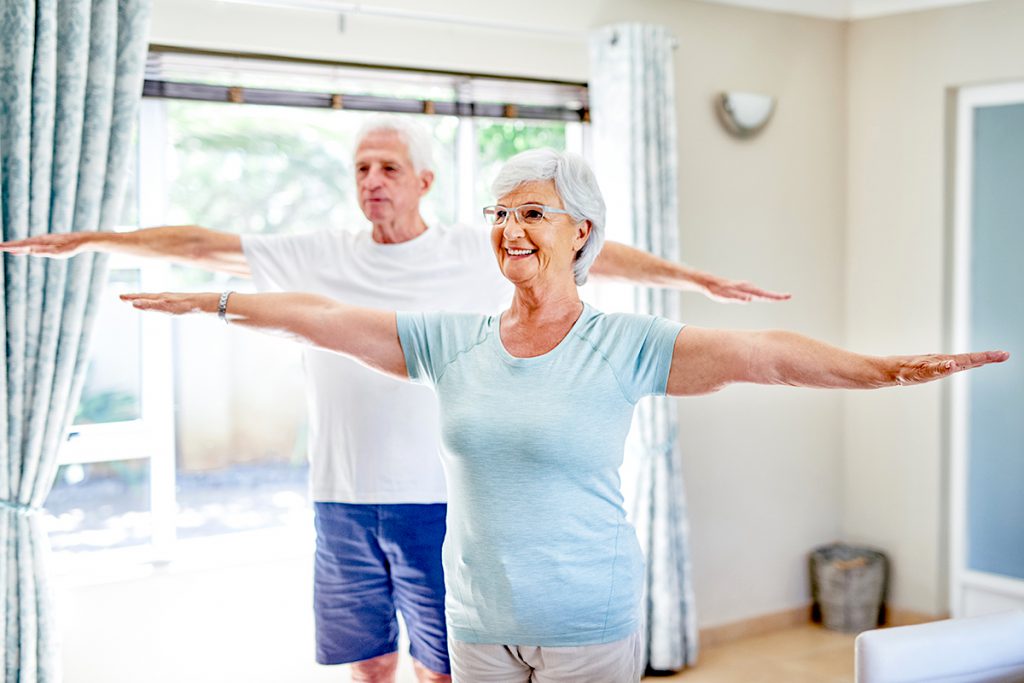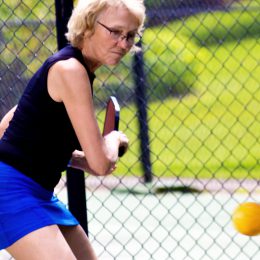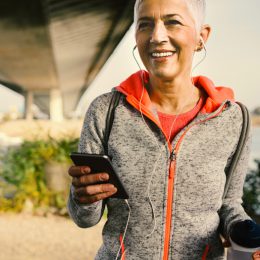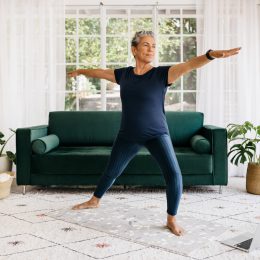Stay Mobile for Life: A Plan for Older Adults
How to improve strength and flexibility, so that you can stand up, sit down, and continue to do the things you love.

Life has plenty of ups and downs—literally. Housecleaning, gardening, playing with grandkids, and other everyday activities require standing up and sitting down, often on the floor. As we age, these movements get more challenging.
Here’s why it happens, and what you can do to stay mobile enough to do the things you love.
Why Do We Lose Mobility As We Age?
When you’re a kid, bouncing up and down from the floor isn’t a big deal. And even heading into middle age, many people still have the ability to rise up without grabbing onto a chair for support.
But age-related muscle loss can start to accelerate in middle age, and conditions like diabetes or obesity can also have an effect, research notes. Lack of exercise and sedentary behavior can also play a part, causing you to lose muscle strength.
When you add in reduced mobility from a decreased range of motion, it makes handling those ups and downs tougher. Why does that matter? Because it could be significantly affecting your quality of life—and even how long you live.
A study in the European Journal of Preventive Cardiology found that those who were able to get up from sitting on the floor without using their hands or other assistance tended to have longer lifespans than those who couldn’t.
If You Don’t Use It, You’ll Lose It
Getting up and down isn’t the only limitation you might find as you age. There could be concerns with lifting heavy objects without hurting your back, twisting to look behind you, and even reaching overhead for a box or a serving dish.
“When people get older, they tend to reduce their range of motion,” says Sheri Saperstein, C.P.T., a trainer who works with seniors. “For example, they may not put items on high or low shelves anymore, so they’re not reaching as much as they once did. Or in the car, they use a backup camera instead of looking over their shoulder. These might seem minor, but when it comes to movement, that’s a ‘use it or lose it’ situation.”
The same goes for those ups and downs. When you stop sitting on the floor, you don’t need to get back up from that position anymore. People tend to gravitate toward sitting at the same level—chairs, couches, car seats, restaurant booths—which all put you in roughly a similar position. Much like never reaching overhead, that can start to limit your mobility, and you might not realize it until you find yourself having to get up from a lower height.
In general, mobility depends on factors like strength, flexibility, and balance. Let’s take a look at key ways to improve all three.
How to Build Your Strength
Lift weights, jump around a little. That’s the advice for building more bone density, improving muscle mass, and supporting joint health, according to Belinda Beck, Ph.D., researcher at Griffith University in Australia and director of the Bone Clinic, a health service focusing on bone, muscle, and joint health.
“As we age, we sometimes get the mistaken impression that we should move less to ‘protect ourselves’ when it’s actually the opposite,” she says. “The more you move, the more you’ll protect yourself in numerous ways, including lowering your risk of chronic conditions and managing those ups and downs of aging on every level, including physically, mentally, and emotionally.”
Strength training, also called resistance training, involves lifting some type of weight, but that also includes bodyweight. You’re working against gravity, Beck says. That helps to build muscle mass, especially if you follow a program that involves progressive increases in resistance.
In terms of jumping, what’s right for your bones and joints will depend on your personal health and fitness level. For some people, small hops or jumps that you might find in fitness classes are helpful. For others, who are not at risk of falling, jumping rope can be a good option, Beck says.
As always, safety is key. If you have a chronic condition, an injury, or balance issues, talk to your doctor about how you can exercise safely. Plus, learn more about high-impact exercise for older adults here.
How to Gain Flexibility
When they hear the term “flexibility,” many people tend to think about extremely flexible yoga teachers or gymnasts—or at least people who can touch their toes without bending their knees.
However, flexibility has a different meaning for everyone, says Saperstein. In general, it usually means being able to move in new ways without feeling restricted. The best way to do that? Move in new ways.
Subscribe to our newsletter
It's quick and easy. You could be one of the 13 million people who are eligible.
Already a member? Click to discover our 15,000+ participating locations.
Follow Us
“Our bodies begin to fall into movement patterns, and we all tend to take the path of least resistance,” says Saperstein. “If you stop challenging yourself, it becomes harder to break out of those patterns.”
Practices like yoga, tai chi, Pilates, and dynamic stretching can all be helpful for introducing movements you might not do otherwise. Your body will adjust over time to accommodate these activities. You might feel like the Tin Man at your first yoga class, but after six weeks, you may be surprised at how much more you can do, comfortably, compared to that initial session.
Again, it’s a good idea to check with your doctor if you have any health conditions. For example, Beck does not recommend doing deep forward-bending stretches if you have spinal osteoporosis.
How to Achieve Balance
Here’s the reward for focusing on strength and flexibility: Balance tends to come along with it. Core strength is an essential aspect of balance, so workouts that focus on core strength or balance will gradually improve your stability over time.
Find great ways to improve your balance here.
As with all activity, it’s a good idea to check with your doctor first to get the go-ahead, and then start gradually, Beck suggests. Making incremental progress is key to building strength, flexibility, and balance in ways that can support long-term mobility.
Take Your Favorite SilverSneakers Classes Online!
SilverSneakers members can access live fitness classes and wellness workshops through SilverSneakers LIVE. See the latest schedule and RSVP for classes here.
Not a member? If you have a Medicare Plan, it may include SilverSneakers—at no additional cost. Check your eligibility instantly here.





